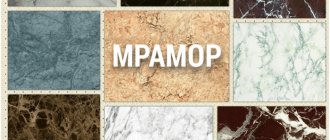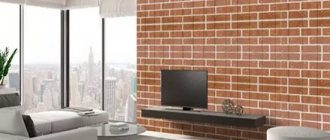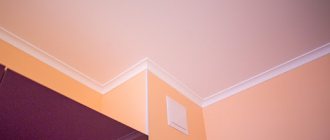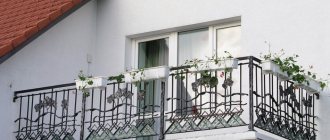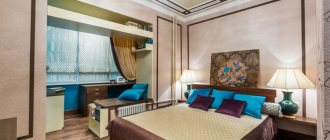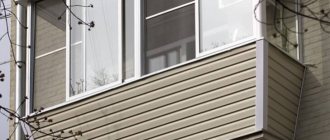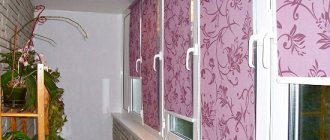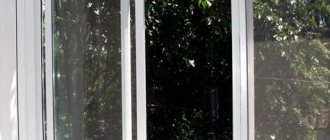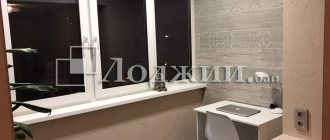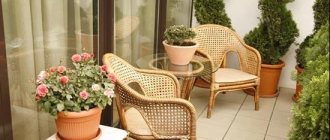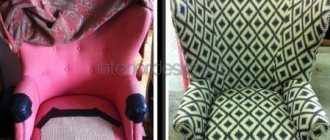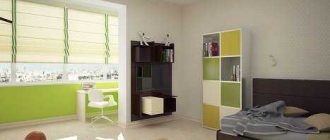Balconies and loggias are no longer an underrated space. With the advent of new technologies, they began to be glazed, insulated and turned into a comfortable room. However, protection from wind or cold alone is not enough for comfort. An aesthetic component is required, which is created using interior design. High-quality interior decoration of the balcony will transform the space. But you need to choose the right materials.
What to consider when choosing finishing materials
Interior decoration of the balcony is the final stage of renovation of the balcony space. First, work on glazing, waterproofing, and insulation is carried out. When they are completed, it is time to finish using decorative elements.
The choice of interior decoration depends on a number of factors:
- Purpose of the premises.
- Functionality of space.
- Design of a nearby room. Because there should be no contrast.
Interior decoration of the loggia
Finishing materials are selected such that they correspond to the conditions of the balcony or loggia. They should be:
- Moisture resistant. Since the humidity on the balcony is higher than in the room.
- Durable. Service life is from two to three decades.
- Resistant to temperature changes with ultraviolet radiation.
- Thermal insulating.
- Protecting against noise.
- Safe for human health.
General provisions
Finishing the balcony-loggia on your own
Doing all the finishing work on the balcony with your own hands is much more profitable than hiring professional workers for this purpose. It's all about the small area of this room. It’s just enough for you to show off your own design and construction skills without fear of seriously ruining something, but it’s not enough to call a highly paid specialist.
But, as we have already noted, you should approach the implementation of your plans correctly. And only then can you count on a high-quality result.
Variety of materials for wall decoration
The walls of balconies and loggias are decorated with different materials. These surfaces are not subject to stress like floors, so weak and abrasion-resistant options are suitable for them.
Wooden lining
Wooden lining consists of slats with grooves for fastening and a certain profile of the outer side. The balcony, covered with wood, is well sound and heat insulated. Properly treated dry wood lasts a long time. Besides, it looks original. Lining is considered a natural, environmentally friendly product. The main thing when processing is to choose compounds that are safe for humans and intended for internal work.
Balcony finishing with clapboard
The cost of lining depends on the class of material and type of wood:
- Cheap pine and spruce.
- Lining made from soft hardwood is more expensive.
- The most expensive of hardwoods.
Cork finishing
Another natural material is cork. It is made from the bark of the cork tree. During hot pressing, cork particles release lignin, which glues them together. Moreover, a monolithic material is created. Cork is not afraid of moisture, heat, or cold. It does not fade in the sun, perfectly insulates, and blocks out external noise.
Finishing the balcony with cork
Static electricity does not accumulate in such a coating, so the surface collects less dust. Using cork it is easy to create a stylish finish. Disadvantages include relatively high cost and uniform appearance. The material is supplied in rolls or in the form of modular tiles.
MDF panels
MDF is medium density fiberboard. They are available in several versions:
- Flat.
- Embossed.
The surface of the board is covered with veneer or polymer film. The coating imitates the color and pattern of natural wood of different species.
MDF balcony finishing
MDF has many advantages that make it possible to prefer this option. Fiberboards are good in use. Their design is varied. The external finish of the slab imitates wood, but there are also options with plain coatings. Installation of the panels is simple. They can be installed in any direction. MDF is attached to the sheathing, so there is space for placing insulation.
Plastic panels and siding
Finishing balconies with plastic panels is a budget option. They attach simply. The work is carried out in-house. Plastic panels are durable, they do not rot, and do not absorb moisture. The panels vary in appearance. Color ranges from light neutrals to vibrant shades.
Balcony finishing using plastic panels
But bright colored options should not be used for a balcony on the sunny side. But the plastic finish is not without its drawbacks:
- Sensitivity to mechanical damage.
- Negative reaction to sudden temperature changes. Therefore, panels are used for insulated spaces.
- Fast fading when exposed to ultraviolet radiation when installing on the sunny side.
The advantages of this material are price and ease of care. The panels retain heat well and insulate noise.
Finishing the balcony with siding
Vinyl siding is more resistant to temperature changes. This material is also used for internal cladding of the balcony space. Siding has a longer service life than plastic panels. It can be used to inexpensively decorate a balcony. But the resistance to mechanical damage of this material is low. In addition, it has less variety of color shades.
Block house for finishing a balcony
A block house is a group of materials that imitate the appearance of a wooden frame made from logs or timber. For production use:
- Tree.
- Metal.
- Polymers.
Block house with balcony decoration
A vinyl polymer block house weighs ten times less than a wooden one. This modern option will not create additional load on the wall or supporting structure. A natural wooden block house is suitable for lovers of naturalness and authenticity. With its help, a complete feeling of log or timber walls is created. The balcony has a certain flavor. The advantage of this finish is its design, soundproofing and heat-insulating characteristics. If vinyl or metal panels are used, they do not suffer from temperature changes and do not fade in the sun. Using a block house is more expensive than clad with wood clapboard or vinyl siding.
Laminate for wall cladding
Laminate is commonly used as flooring. But they also line balcony walls. The result is a smooth surface in a variety of colors. The material is environmentally friendly, lasts a long time and is easy to install.
Laminate finishing for balconies
When choosing a laminate, take into account certain features:
- Laminate does not like temperature changes.
- Does not tolerate changes in humidity.
Such factors lead to deformation of the boards and peeling of the top layer. Laminate is used on a well-insulated, heated and ventilated balcony.
Plasterboard finishing
Finishing of balcony surfaces with plasterboard is carried out in combination with decorative coatings. Plasterboard sheets are used for leveling and creating a base. Then the base is painted, plastered or covered.
Balcony finished with plasterboard
Moisture-resistant drywall is most often used. It is reliable and durable and will create a smooth base for subsequent decoration.
Balcony finishing with plaster
Drywall is painted with water-based or other paints that allow water vapor to pass through. For plastering, any material options are chosen. From those creating a smooth finish to textured ones.
Cladding balcony walls with plastic
Modern technologies make it possible to use only high-quality and high-tech materials for repair work, which are incredibly versatile, durable and wear-resistant. Their cost also plays a significant role, which should be affordable to everyone.
Today, it is very popular to cover loggias with plastic panels, which are in many ways superior to expensive wooden panels, for example, such as lining.
Advantages of cladding with this material:
- It retains heat perfectly, preventing cold from getting inside.
- This material is not susceptible to humid environments, temperature changes and all kinds of atmospheric influences.
- Easy to clean every day: just wipe the plastic with a damp cloth to keep it clean.
- By combining this material with plastic windows, you can achieve a unique and effective design solution that is built on harmony.
- Thanks to the extremely rich range of colors, you can create the most sophisticated design solutions. Each buyer has access to white, beige, coffee, yellow, gold, brown, blue, red, green and even black shades.
Ceiling and floor materials
The options considered are used more often for walls, but the balcony being finished requires cladding of other surfaces as well. The ceiling and floor have special characteristics and require a special selection of finishes.
Ceiling lining
Finishing the loggia ceiling with clapboard
It is additionally heat and waterproofed. The cladding is not attached directly to the ceiling surface, but to the lathing. Plastic panels, lining or plasterboard are used as ceiling cladding.
Finishing the balcony ceiling with panels
Putty for loggias and balconies
One of the most popular finishing materials today is putty. The lamellar, viscous composition is capable of perfectly leveling any surface, thereby creating an excellent base for applying paint or wallpaper. Putty is mainly used for leveling walls and ceilings indoors and preparing facades outside buildings.
There are several types of mixtures, we will look at each of them in this article, and first we will study the positive and negative aspects of putty.
Let's start with the pros:
– the uniform viscous structure of the putty allows you to easily and quickly distribute the material over the surface to be treated. When applied correctly, the putty does not slip or drip, but is fixed in surface unevenness, creating a perfectly flat base;
– putty belongs to the category of quick-drying materials, which allows you to quickly and effectively prepare the surface for applying the finishing coating;
– one of the main advantages of putty is the ability to quickly correct mistakes (protruding parts can be cleaned using a special grout block, and depressions can be puttied again);
– Naturally, one cannot fail to note the low cost of putty.
It’s time to talk about the disadvantages of putty:
– an accurate calculation of the amount of material is required. Having diluted the dry putty mixture with water, you will no longer be able to use it in the future, since the hardening speed is two to three hours;
– the prepared putty has a very high cost, so using it to treat a large area is very expensive;
– when applying a thick leveling layer, you will have to carry out the coating in several stages, completely drying each layer, which will entail an increase in finishing time;
– the work of applying putty is quite expensive; if you yourself do not have putty skills, you will have to spend a significant part of your budget on paying hired workers.
Let's move on to considering the types of putty:
1. Gypsum putty (in the form of a dry mixture). Already from the name it is clear that the basis of this material is gypsum. So, gypsum putty is very often used as a finishing layer before wallpapering walls. Gypsum putty has a low cost, maintains a good microclimate in the room, does not crack or shrink.
In addition to the above, this putty dries quickly, has no odor and is absolutely safe for human health. Gypsum putty is mainly used in dry rooms with a normal microclimate, since in rooms with high humidity it loses strength and becomes susceptible to mechanical damage.
2. Water-dispersion putty (ready-made mixture on a gypsum basis). This putty is sold as a ready-to-apply mixture. The cost of water-dispersed putty is already higher than that of conventional gypsum putty, but it does not need to be stirred and the proportions must be maintained. It will not be possible to mix gypsum putty so well on your own, so you get the ideal material for leveling surfaces. Like prepared gypsum putty, it is also advisable to use the water-dispersion mixture immediately, but it can sit in the original container for some time and only begin to lose its properties over time.
3. Polymer putty in the form of a dry mixture. This putty will have to be diluted in accordance with the proportions, but it kneads better than gypsum. Ready-made polymer putty is very easy to apply to walls and is therefore used most often. Although the cost of this putty is higher than that of previous types, it is still a top seller and craftsmen really like to use it. In turn, polymer putty can be acrylic or latex.
Acrylic putty is a finishing putty; after its application, the wall or ceiling receives a smooth, even surface, onto which high-quality paint can subsequently be applied. This putty can also be used on wooden surfaces.
Latex putty is less expensive than acrylic putty, but its use is limited to interior work. It is not worth applying latex putty to open facades of houses, since it does not tolerate low temperatures and high humidity.
In addition to the listed types, starting and finishing putty should be noted. Starting putty is usually sold in the form of dry mixtures and is intended for initial surface treatment. This mixture often includes gypsum, which, even after thorough mixing, may appear in the form of undissolved debris.
The starting putty fills most of the surface unevenness and dries quickly. In most cases, the starting putty is not enough to perfectly level the surface and a finishing putty is additionally applied on top of it.
The finishing putty has a hardening time of up to twelve hours; unlike the starting putty, it does not contain any large particles and spreads quickly and smoothly over the surface. After applying the finishing putty, the surface is quickly rubbed down, treated with a primer and becomes ready for further treatment with paint or wallpaper.
The building materials market is filled with various brands of putty. Among them there are both domestic products and imported analogues. The choice of putty depends primarily on the structure of the surface being treated and, secondly, on the budget. Consultants from construction companies will also help with the selection of a high-quality mixture; you can study this issue on your own by looking at product reviews and reading construction forums.
But one thing can be stated unequivocally: any repair or finishing of a new building will not be complete without the use of this useful material, and no high-quality plaster will provide you with the smooth surface that is formed after applying putty.
